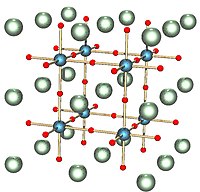
Photo from wikipedia
Narrow-bandgap Sn-Pb mixed perovskite single crystals are highly promising as photoactive materials for efficient and low-cost near-infrared (NIR) photodetectors. However, because of the significant difference in the crystallization velocities for… Click to show full abstract
Narrow-bandgap Sn-Pb mixed perovskite single crystals are highly promising as photoactive materials for efficient and low-cost near-infrared (NIR) photodetectors. However, because of the significant difference in the crystallization velocities for Pb- and Sn-based perovskites, Sn-Pb mixed perovskites are peculiarly prone to phase separation during the crystallization process, causing the degradation of the optical and electronic properties of materials. Herein, we propose a low-temperature space-confined technique (LT-SCT) that simultaneously reduces the crystallization velocities of pure Sn and Pb perovskites, enabling the fabrication of pure-phase (FASnI3)0.1(MAPbI3)0.9 single crystals. The resulting (FASnI3)0.1(MAPbI3)0.9 single crystals exhibit excellent crystallinity with a high hole mobility of 7.44 × 103 cm2 V-1 s-1 and a low surface trap density of 1.88 × 109 cm-2. These properties benefit the application of (FASnI3)0.1(MAPbI3)0.9 single crystals in self-powered NIR photodetectors and yield outstanding comprehensive performance, especially with a broad linear dynamic range of up to 163.5 dB, a large responsivity (R) of 0.53 A W-1, and a fast response speed of 22.78 μs in the NIR spectral region (750-860 nm). Furthermore, high-quality NIR imaging and wearable health monitoring are achieved by employing high-performance and self-driven NIR photodetectors. This work contributes to developing Sn-Pb mixed perovskite single crystals and provides a promising candidate for efficient and low-cost NIR photodetection.
Journal Title: Nanoscale
Year Published: 2023
Link to full text (if available)
Share on Social Media: Sign Up to like & get
recommendations!